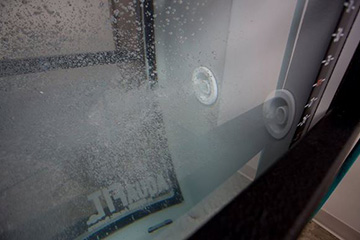Aquatic Therapy for Ortho Patients
Posted
Aquatic therapy has proven beneficial in the treatment and recovery of a variety of orthopedic conditions, both surgical and nonsurgical. Because the unique properties of water offer numerous benefits, such as buoyancy, hydrostatic pressure, viscosity, and thermodynamics, treatment intervention can begin sooner resulting in the patient progressing more quickly. Although utilizing water is very beneficial, best clinical outcomes are achieved when aquatic therapy and land therapy are used in conjunction throughout the patient’s treatment.
Properties of water and unique benefits:
- Buoyancy Clinical Significance-
- Decreases weight bearing and joint compressive forces
- Assists with movements performed at slow speeds (Active Assistive Range of Motion)
- Unweights the body up to 90% at neck deep submersion
- Hydrostatic Pressure Clinical Significance-
- Pressure exerted on the body is equal on all surfaces, aids in reducing edema
- Viscosity Clinical Significance-
- Provides 360 degrees of resistance throughout the workout.
- Thermodynamics Clinical Significance-
- Typical aquatic rehab temperatures range from 88-92 degrees
- Warm temperatures promote relaxation, decrease muscle tightness and muscle spasms
- Blood flow to muscles increases
Utilizing added options during aquatic treatment, such as underwater treadmills and therapy jets, provide added benefits.
Underwater Treadmills allow patients to focus on functional activities, such as gait, at controlled speeds and water depths specific to their needs. Underwater treadmills can also be utilized for conditioning. Working out in water has many benefits; reduction in body weight, because of water’s natural buoyancy, allows athletes to work out harder, at higher intensity levels, more days in row.
Jets can be utilized for resistance (strengthening) purposes or aid with range of motion activities. When completing exercises, by facing all four directions, the jets can be utilized for resistance or assistance based on body position.
Orthopedic Conditions Benefitted by Aquatic Therapy Treatment:
- • Non-Surgical Shoulder Diagnosis- Adhesive capsulitis, labral/rotator cuff pathology, shoulder osteoarthritis
- – Water provides a calming environment to focus on stretching and strengthening- buoyancy assists with planes of stretching not available on land.
- – Buoyancy buffers quick movements, results in decreased pain and increased range of motion
- – Patients can focus on neuromuscular control utilizing laminar flow (provided by jets)
- – Warm temperatures decrease pain and allow for increased range of motion (most beneficial for OA patients)
- • Post-Operative Shoulder Diagnosis- Rotator cuff repair, total shoulder replacement (including reverse), labral repair/shoulder stabilization
- – Aquatic therapy can be initiated in the early, protective phase to assist in gentle strengthening and range of motion, neuromuscular control, proprioception, and relaxation/pain control
- – Water allows patients to move in planes they are unable to on land secondary to the force of gravity
- – Laminar/turbulent flow (from jets) can be utilized to assist with motion in early phases and to resist motion in later phases
- – Relaxing environment allows patients to focus on range of motion goals
- • Non-Surgical Spinal Diagnosis- Chronic low back pain, lumbar stenosis, spinal compression fracture, ankylosing spondylitis
- – Pain decreases in an aquatic medium, warm temperatures promote relaxation and decrease spasms
- – Buoyancy of the water unloads the spine, increasing tolerance to functional activities. Focus on activating the core in unloaded position
- – Flexibility is addressed by utilizing different water depths and pool equipment to assist with stretching and ROM
- – Progress to strength training activities using the resistance of the water
- • Surgical Spinal Diagnosis- Spinal fusion, decompression surgeries, vertebroplasty
- – Aquatic rehab can be done while maintaining spinal precautions, often beginning sooner than land therapy
- – Maintain a neutral spine and activate core muscles for focus on stability
- – Option of utilizing aquatic traction with patients who may not be appropriate for traction table
- • Non-Surgical and Surgical Lower Extremity Diagnosis-
Non-Surgical: Hip and knee osteoarthritis, ankle sprains, calf strains
Surgical: Total Hip Replacement, Total Knee Replacement, ACL repair, knee/ankle ORIF, Achilles repair
-
- – Aquatic medium allows for gentle strengthening
- – ROM increases while experiencing less pain
- – Buoyancy of water provides assisted range of motion in beginning stages of rehab and resisted range of motion in later stages
- – Patient can focus on balance in a safe environment, joints are unweighted for decreased pain
Four phases of Aquatic Rehab for Ortho Patients:
- Mild stretching, range of motion, buoyancy assisted and supported activity
- Buoyancy resisted exercises and single joint movements
- Functional movement patterns, low intensity plyometrics, open and closed chain exercises
- Sport specific movement patterns and advanced plyometrics
Aquatic treatment provides earlier intervention and better outcomes for surgical and non-surgical patients while utilizing the natural properties of water, focus on decreasing pain, increasing range of motion, and increasing strength. With the addition of equipment and utilizing therapy jets and underwater treadmills, treatment sessions can be progressed with the stages of recovery.




